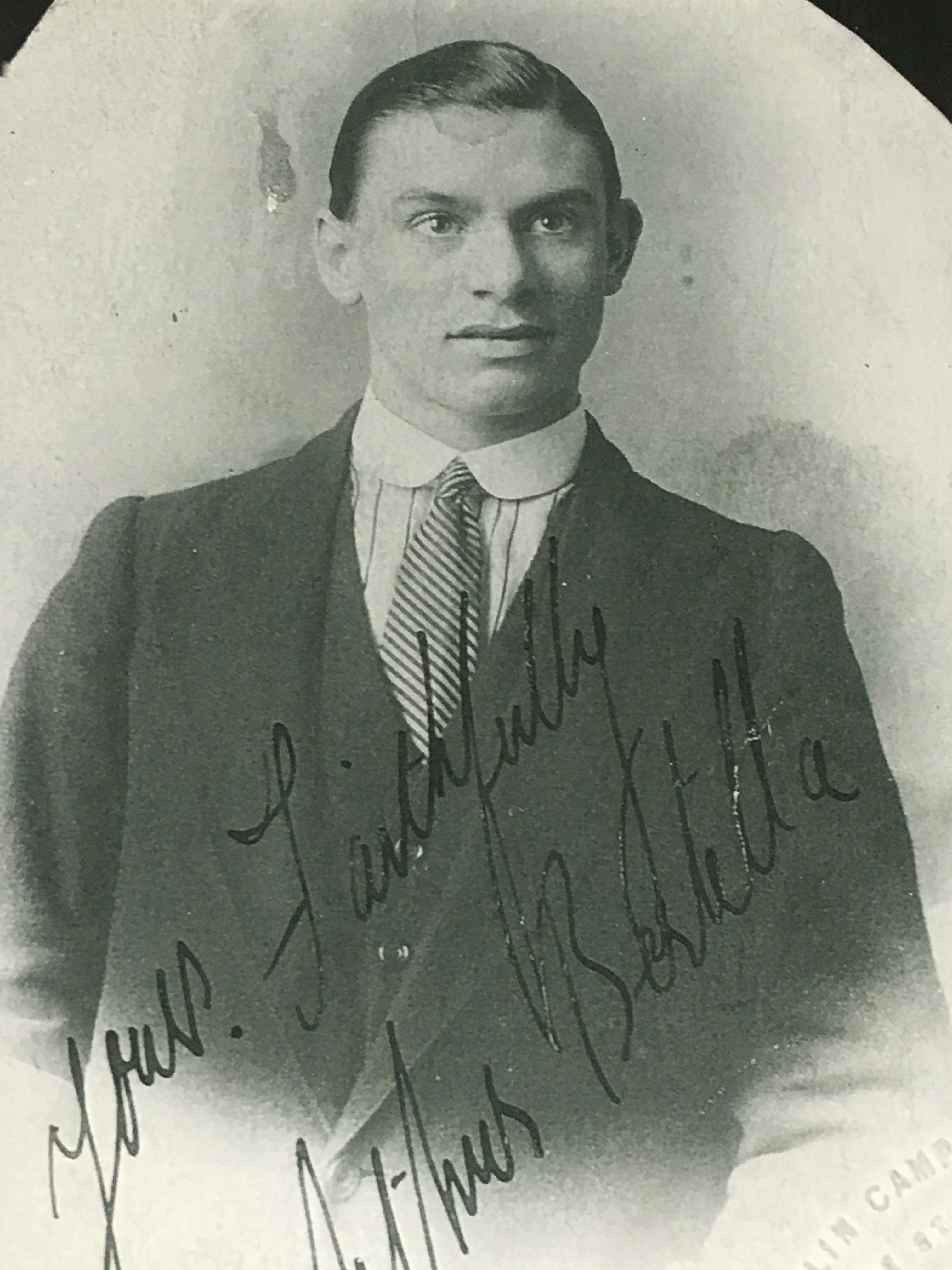Sjt
Bertie Greenfield
Information about birth
|
Date of birth: 26/07/1895 |
|
Place of birth: Nottingham, Nottinghamshire, England, United Kingdom |
General information
|
Profession: Music hall Acrobat |
Army information
|
Country: England, United Kingdom |
|
Force: British Expeditionary Force |
|
Rank: Serjeant |
|
Service number: 16534 |
|
Units: — Dorsetshire Regiment, 5th Bn. (Last known unit) |
Information about death
|
Date of death: 04/10/1917 |
|
Place of death: Poelcapelle, Belgium |
|
Cause of death: Killed in action (K.I.A.) |
|
Age: 22 |
Memorial
|
Tyne Cot Memorial Panel: 92 |
Distinctions and medals 2
|
British War Medal Medal — 15/07/1920 |
|
Victory Medal Medal — 15/07/1920 |
Points of interest 2
| #1 | Place of birth | ||
| #2 | Place of death (approximate) |
My story
Serjeant Bertie Greenfield served in the Dorsetshire Regiment 5th Battalion. This Battalion was part of the 34th Brigade of the 11th Division of the British Expeditionary Force. Before he was conscripted, Bertie was a stage performer in a tumbling act, with the Joe Boganny Troupe.
On Thursday 4 October 1917, the 11th Division participated in the Battle of Broodseinde. The attack was planned at 6 a.m. and was carried out by the 9th Lancashire Fusiliers and the 11th Manchesters, with the 5th in support. The Battalion reached their position, east of the Steenbeek and northwest and southeast of Maison Bulgare, at 8 a.m. Thirty minutes before the attack, the Germans started to put down a light barrage, but most of the shells fell in rear of the positions of the 11th Division.
The first goal of the attack of that day was to reach the Red Dotted Line, which ran from northwest to southeast, a little distance east of Poelcappelle. This objective was reached without heavy casualties. The 5th Battalion was ordered to deal with German counter-attacks, but only moved forward when the second objective, the Red Line, which included Meunier Farm and Beek Houses, was reached. The 5th was brought up to support the attack with the 6th Borderers, due to a German counter-attack at 1 p.m. By the time the 5th reached the Red Dotted Line, at 3 p.m., they were ordered to return, due to an uncertain situation on the left. A successful German attack would force the men in a salient too pronounced to be defensible.
Hereby, the 5th had to return to their original positions, which resulted in an increase of casualties. Through the night of October 4th/5th, things were quite lively, with some counter-attacks, with guns, snipers and bombs. The attack was described as most successful, with a significant role attributed to good weather.
Serjeant Bertie Greenfield is mentioned as one of the 11 men, of which 1 officer and ten other ranks, who were killed during the attack of October 4th, which was part of the Battle of Broodseinde. He was killed in action, possibly just south of Poelcappelle. The remains of Serjeant Bertie Greenfield were never recovered or never identified. He is remembered at the Tyne Cot Memorial.
On Thursday 4 October 1917, the 11th Division participated in the Battle of Broodseinde. The attack was planned at 6 a.m. and was carried out by the 9th Lancashire Fusiliers and the 11th Manchesters, with the 5th in support. The Battalion reached their position, east of the Steenbeek and northwest and southeast of Maison Bulgare, at 8 a.m. Thirty minutes before the attack, the Germans started to put down a light barrage, but most of the shells fell in rear of the positions of the 11th Division.
The first goal of the attack of that day was to reach the Red Dotted Line, which ran from northwest to southeast, a little distance east of Poelcappelle. This objective was reached without heavy casualties. The 5th Battalion was ordered to deal with German counter-attacks, but only moved forward when the second objective, the Red Line, which included Meunier Farm and Beek Houses, was reached. The 5th was brought up to support the attack with the 6th Borderers, due to a German counter-attack at 1 p.m. By the time the 5th reached the Red Dotted Line, at 3 p.m., they were ordered to return, due to an uncertain situation on the left. A successful German attack would force the men in a salient too pronounced to be defensible.
Hereby, the 5th had to return to their original positions, which resulted in an increase of casualties. Through the night of October 4th/5th, things were quite lively, with some counter-attacks, with guns, snipers and bombs. The attack was described as most successful, with a significant role attributed to good weather.
Serjeant Bertie Greenfield is mentioned as one of the 11 men, of which 1 officer and ten other ranks, who were killed during the attack of October 4th, which was part of the Battle of Broodseinde. He was killed in action, possibly just south of Poelcappelle. The remains of Serjeant Bertie Greenfield were never recovered or never identified. He is remembered at the Tyne Cot Memorial.
Sources 3
|
5 Battalion Dorsetshire Regiment , (The National Archives, KEW (TNA), WO 95/1820/1). https://discovery.nationalarchives.gov.uk/details/r/C14303 Further reference |
|
Atkinson C. T., History of the Dorsetshire Regiment, 1914-1919, (Naval and Military Press, 2002, Vol. 3), pg. 70-71. Sources used |
|
McCarthy C., The Third Ypres Passchendaele. The Day-by-Day Account, (London, Arms & Armour Press, 1995), pg. 101. Sources used |
More information 3
|
Commonwealth War Graves Commission Database https://www.cwgc.org/find-records/find-war-dead/casualty-details/840668 |
|
Namenlijst (In Flanders Fields Museum) https://namenlijst.org/publicsearch/#/person/_id=e235e8e1-1120-4cea-b145-26e78b2f202e |
|
Lives of the First World War (Imperial War Museum) https://livesofthefirstworldwar.iwm.org.uk/lifestory/1452048 |
